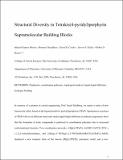Files in this item
Structural diversity in tetrakis(4-pyridyl)porphyrin supramolecular building blocks
Item metadata
| dc.contributor.author | Mishra, Manish Kumar | |
| dc.contributor.author | Choudhary, Hemant | |
| dc.contributor.author | Cordes, David B. | |
| dc.contributor.author | Kelley, Steven | |
| dc.contributor.author | Rogers, Robin | |
| dc.date.accessioned | 2020-04-18T23:32:32Z | |
| dc.date.available | 2020-04-18T23:32:32Z | |
| dc.date.issued | 2019-06-05 | |
| dc.identifier | 258758772 | |
| dc.identifier | 1d59f1c3-8ddd-4eb6-bfce-cf2f531f4953 | |
| dc.identifier | 85065800497 | |
| dc.identifier | 000470938700054 | |
| dc.identifier.citation | Mishra , M K , Choudhary , H , Cordes , D B , Kelley , S & Rogers , R 2019 , ' Structural diversity in tetrakis(4-pyridyl)porphyrin supramolecular building blocks ' , Crystal Growth & Design , vol. 19 , no. 6 , pp. 3529-3542 . https://doi.org/10.1021/acs.cgd.9b00399 | en |
| dc.identifier.issn | 1528-7483 | |
| dc.identifier.other | ORCID: /0000-0002-5366-9168/work/62668389 | |
| dc.identifier.uri | https://hdl.handle.net/10023/19822 | |
| dc.description | The authors would like to thank the University of Alabama Department of Chemistry and the University of Missouri-Columbia Department of Chemistry for support of this work. | en |
| dc.description.abstract | In memory of a pioneer in crystal engineering, Prof. Israel Goldberg, we report a series of new framework solids, based on the ligand tetrakis(4–pyridyl)porphyrin (TPyP). Spontaneous reactions of TPyP with seven different metal salts under liquid-liquid diffusion at ambient temperature show that the formation of ionic compounds is preferred to coordination polymers due to increased conformational freedom. Two coordination networks, {(HgI2)2(TPyP)}n·4nCHCl3∙2nTCE (TCE = 1,1,2,2–tetrachloroethane), and {(Ba(μ1,1–NCS)(μ1,1,3–NCS)(H2O)(MeCN))2(TPyP)}n·4nH2O, displayed a new isomeric form of the known [(HgI2)2(TPyP)]∞ polymeric motif, and a two-dimensional honeycomb polymeric motif linked by hydrogen-bonding into a three dimensional moganite (mog) net, respectively. Four protonated porphyrinic salts, [H3TPyP][PF6]3∙0.5TCE, [H2TPyP][I3]2·2MeOH, [H4TPyP][UO2Cl4]2·6MeCN, and [H4TPyP][Th(NO3)6][NO3]2, were observed which hydrogen bond to give one- or two-dimensional networks, or in the case of [H4TPyP][UO2Cl4]2·6MeCN, a discrete dinuclear hydrogen-bonded complex. In one case, a neutral, hydrogen-bonded complex, Ce(NO3)3(MeOH)3(H2O)·TPyP·TCE·H2O, was formed which adopts a three-dimensional, self-penetrated variant of the face-centered cubic (fcc) network. These new structures represent hybrid organic-inorganic crystalline compounds in which the multidentate porphyrin units, having both hydrogen bonding, as well as coordination functionalities, are interlinked through the inorganic connectors into self-assembled three-dimensional architectures. This work shows the relative stability of noncovalently bound vs. coordination networks as well as the effective potential of the TPyP building block to construct supramolecular assemblies in the presence or absence of coordinating ions as linkers. | |
| dc.format.extent | 3670527 | |
| dc.language.iso | eng | |
| dc.relation.ispartof | Crystal Growth & Design | en |
| dc.subject | Porphyrins | en |
| dc.subject | Coordination polymers | en |
| dc.subject | Topological analysis | en |
| dc.subject | Liquid-liquid diffusion | en |
| dc.subject | Hydrogen bonding | en |
| dc.subject | QD Chemistry | en |
| dc.subject | DAS | en |
| dc.subject.lcc | QD | en |
| dc.title | Structural diversity in tetrakis(4-pyridyl)porphyrin supramolecular building blocks | en |
| dc.type | Journal article | en |
| dc.contributor.institution | University of St Andrews. School of Chemistry | en |
| dc.contributor.institution | University of St Andrews. EaSTCHEM | en |
| dc.identifier.doi | 10.1021/acs.cgd.9b00399 | |
| dc.description.status | Peer reviewed | en |
| dc.date.embargoedUntil | 2020-04-19 |
This item appears in the following Collection(s)
Items in the St Andrews Research Repository are protected by copyright, with all rights reserved, unless otherwise indicated.

